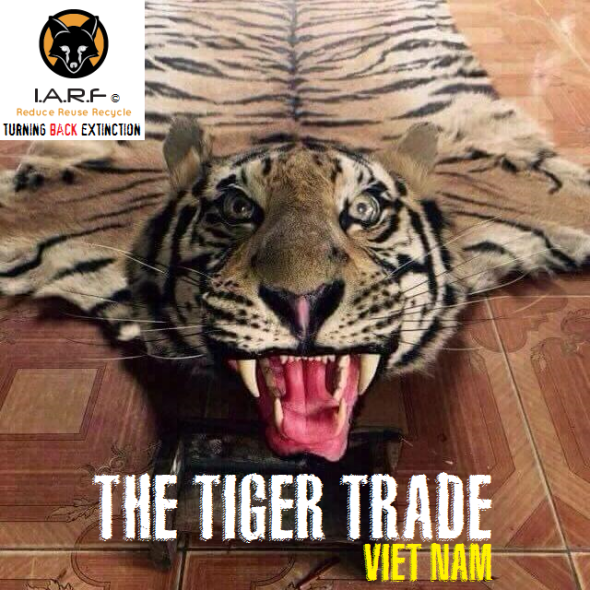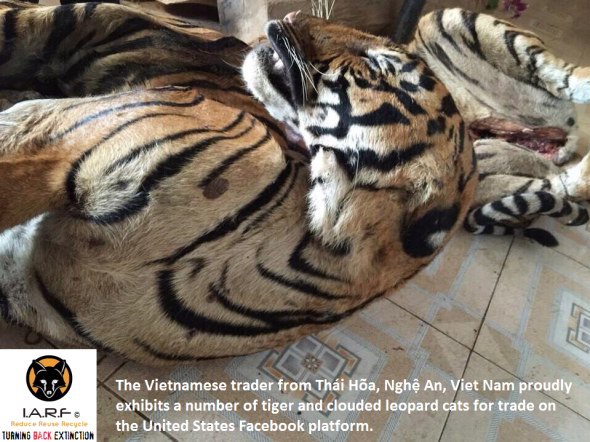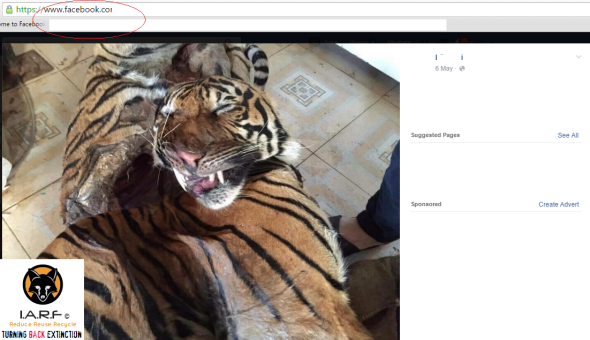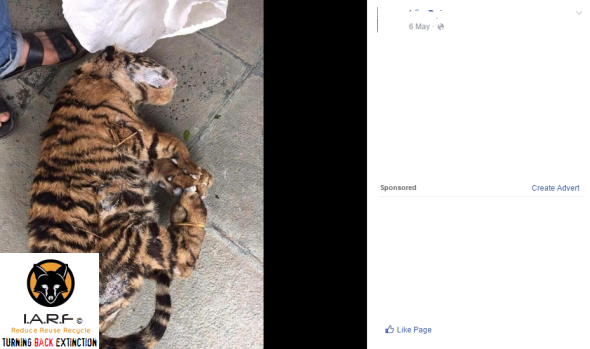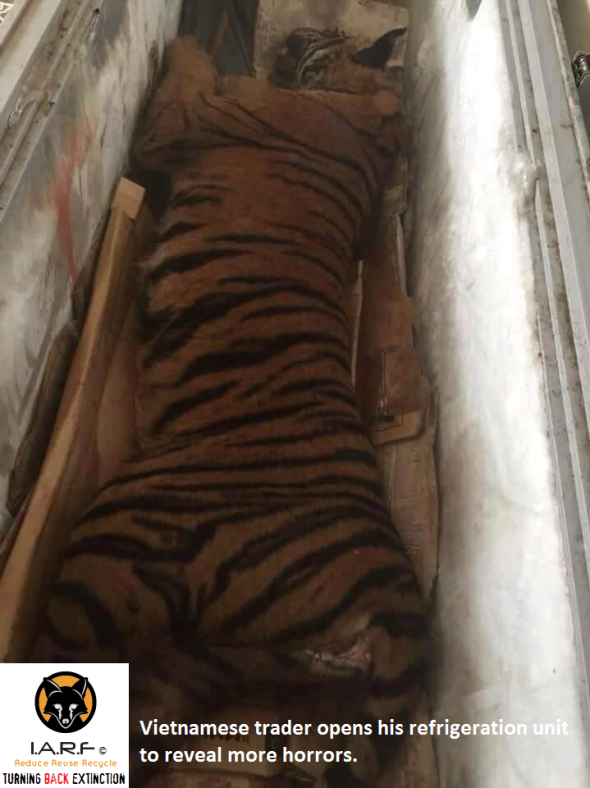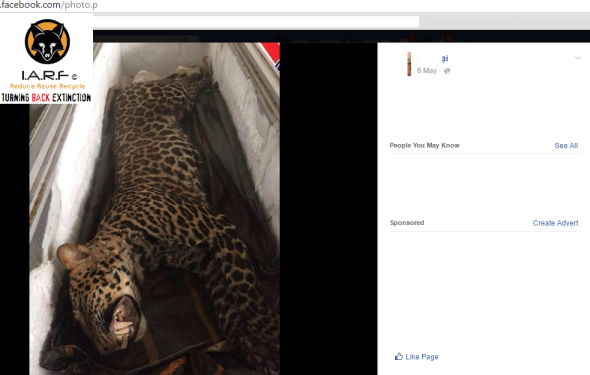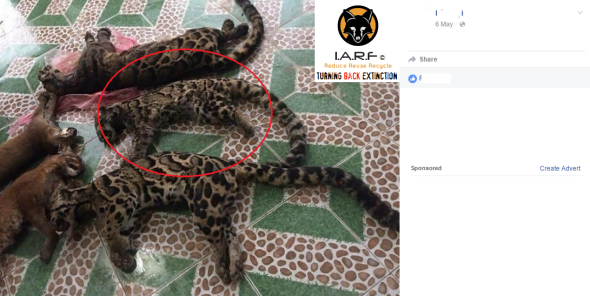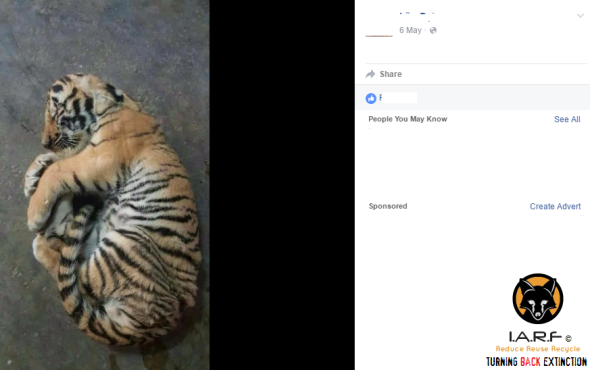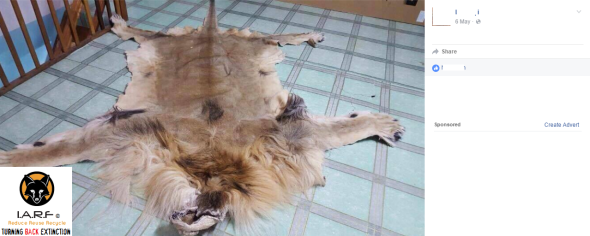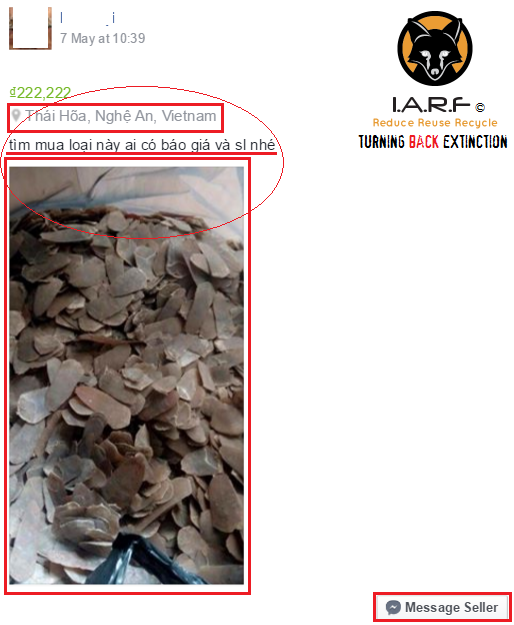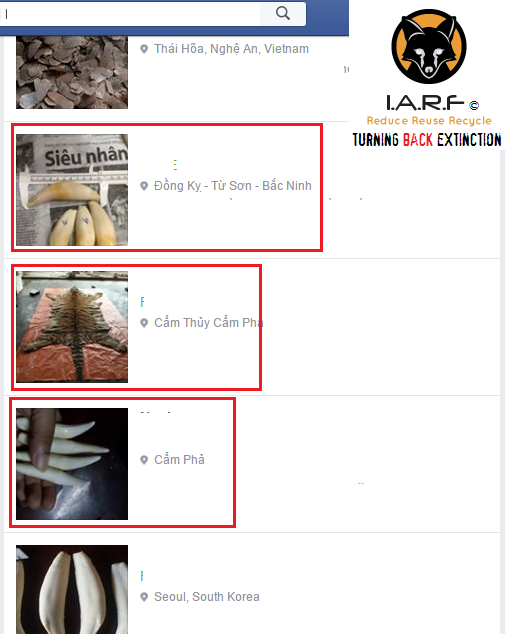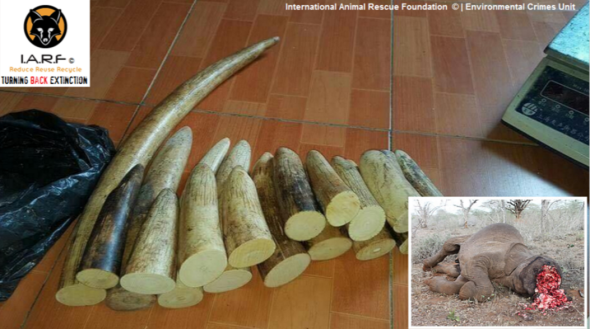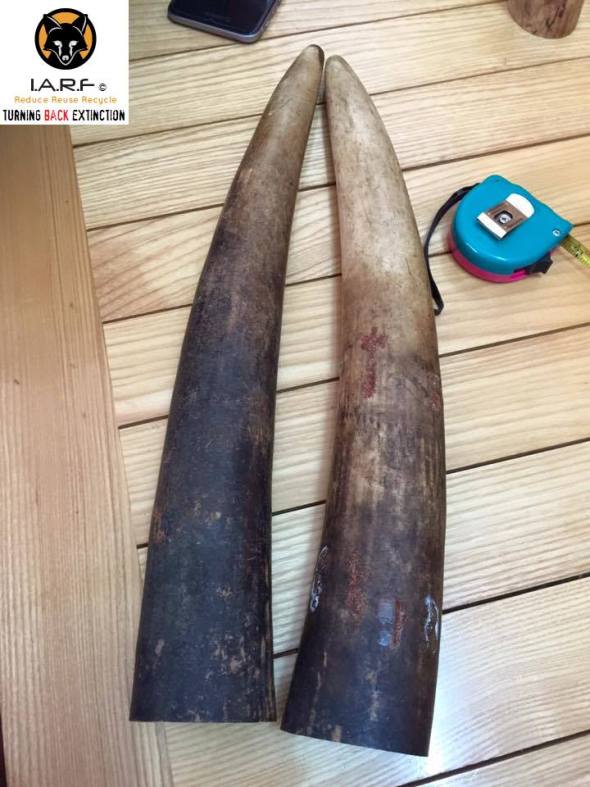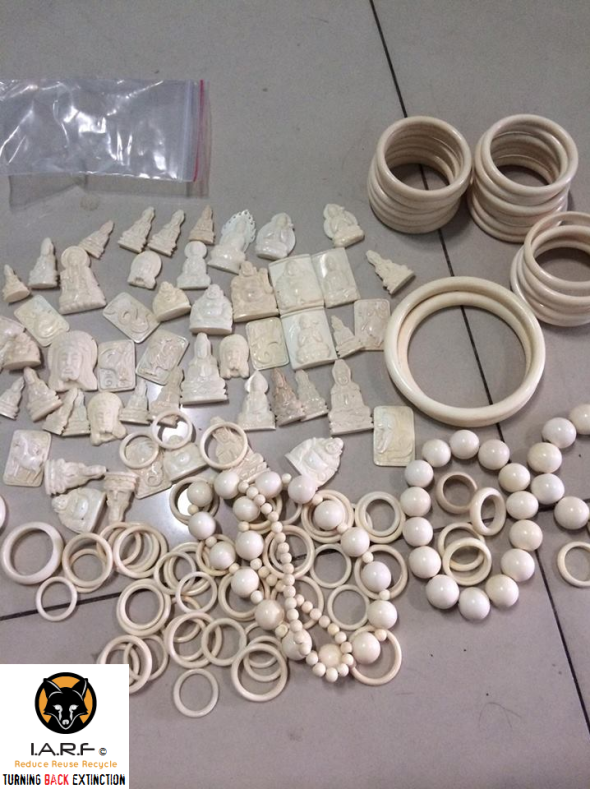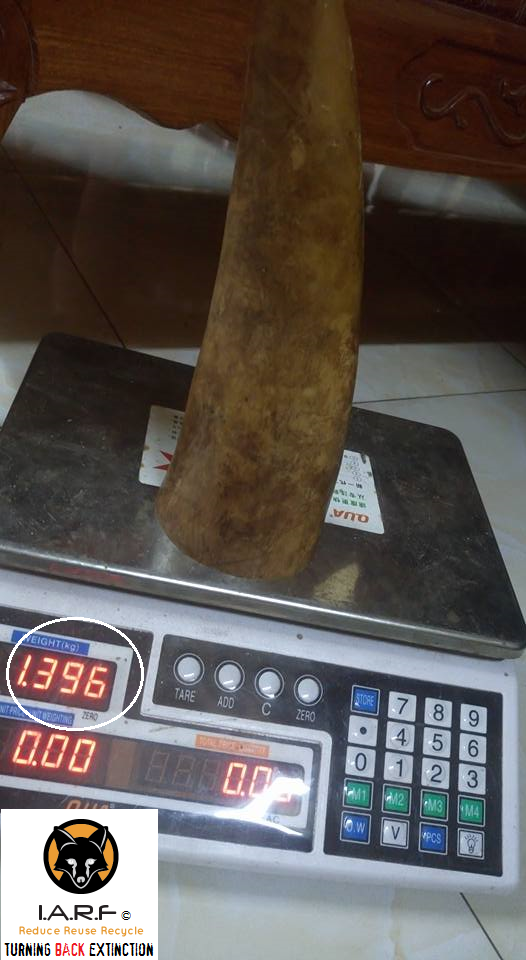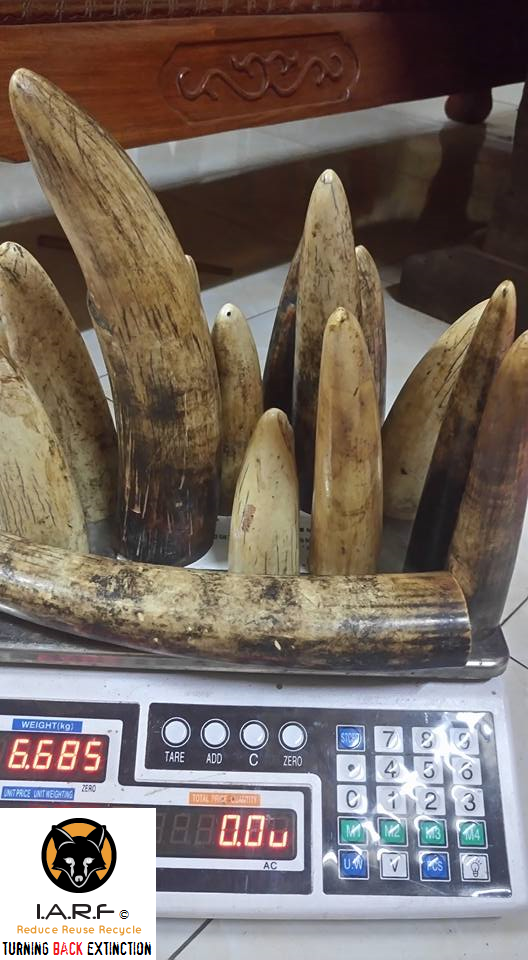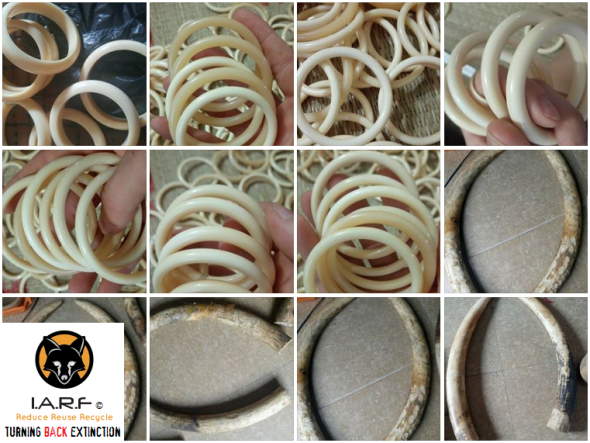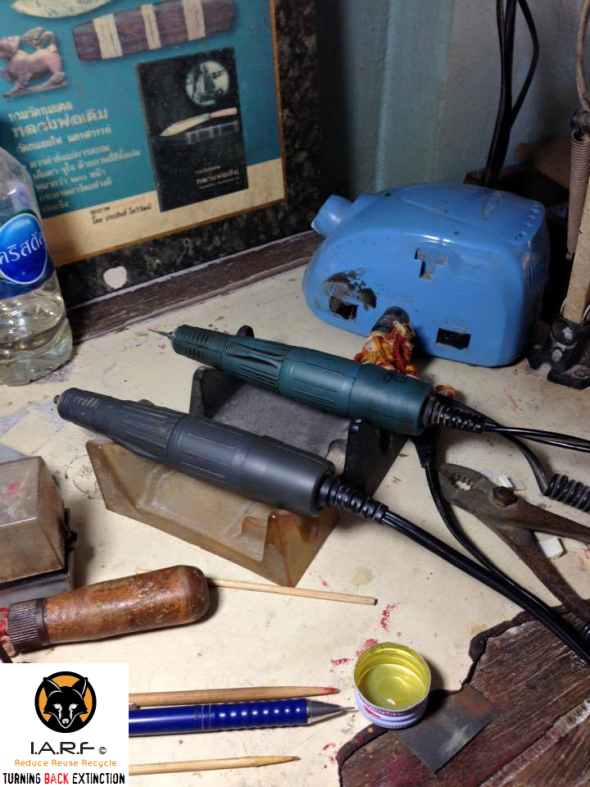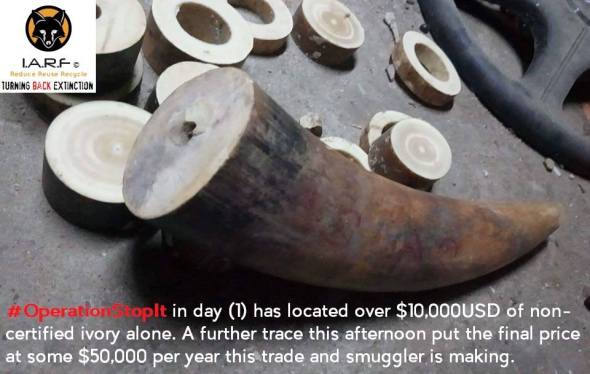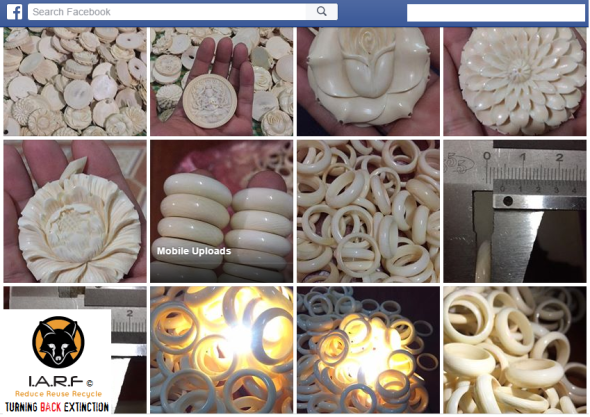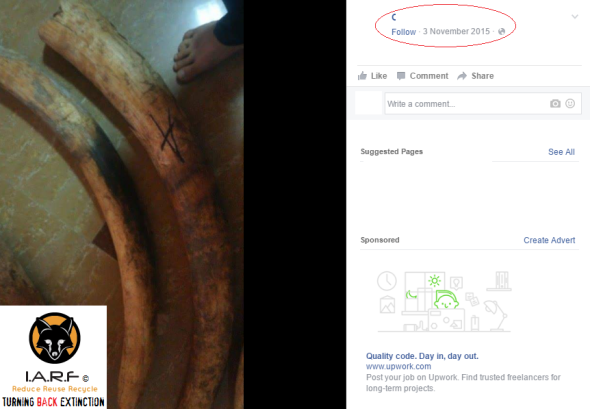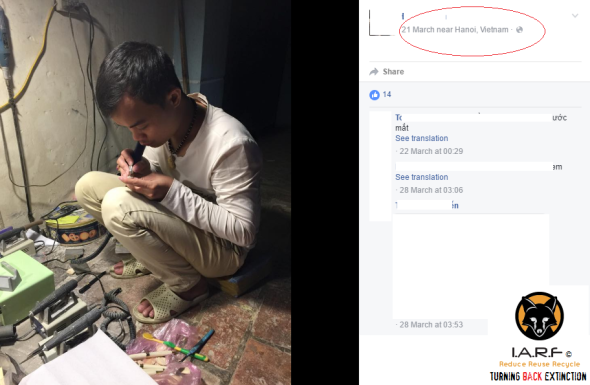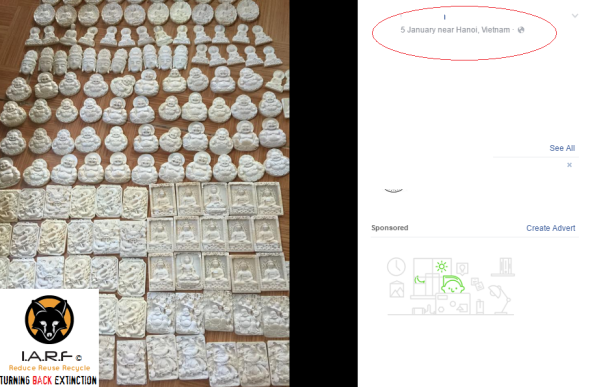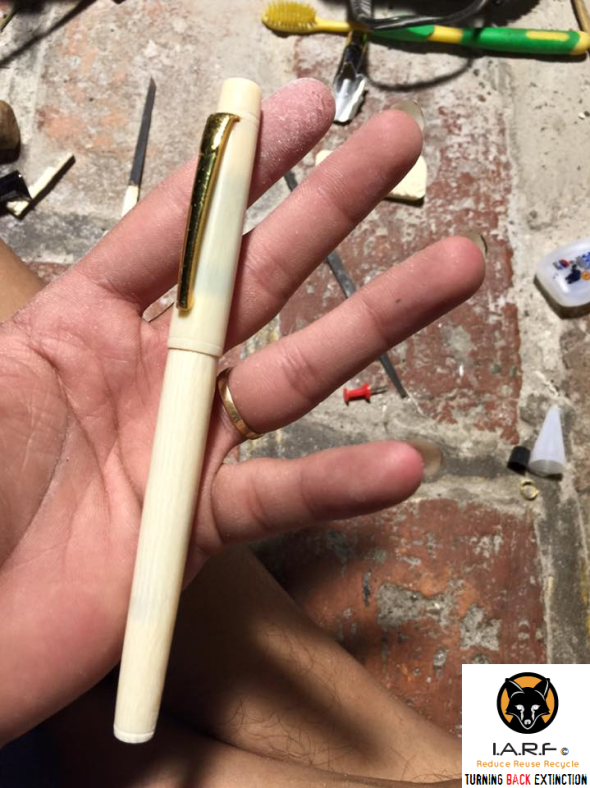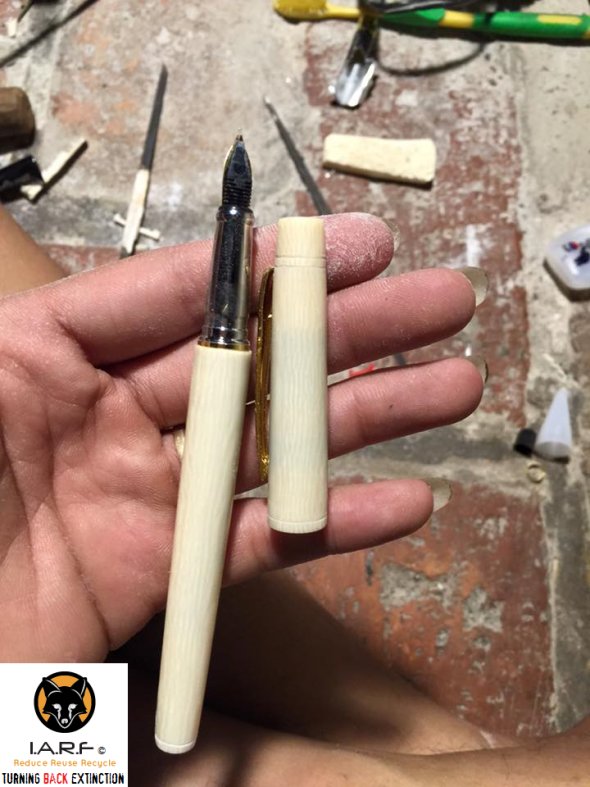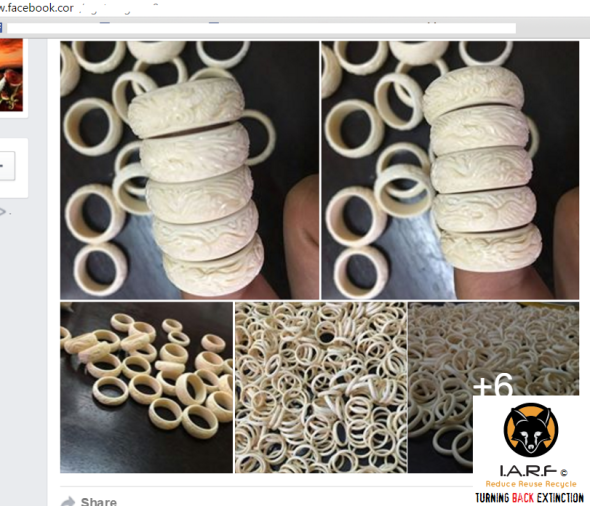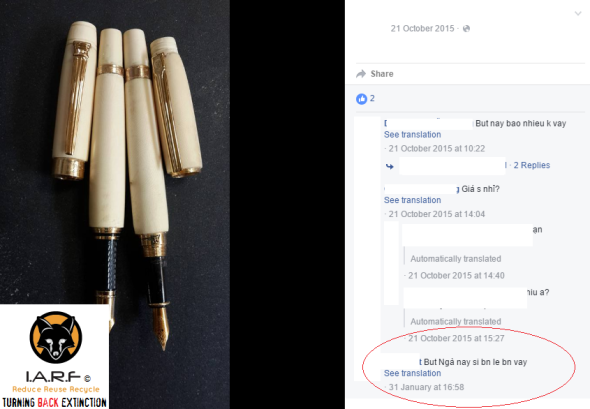FACEBOOK: TIGER PARTS TRADE | HORROR IN VIET NAM | PART II
TIGER TRADE | VIET NAM
The images your about to view in this article have all originated from an ongoing investigation into the illicit animal parts trade online and on the ground in South East Asia. My name is Dr Jose C. Depre, for some five years now my environmental and animal crimes investigation company has continued to delve deeper and deeper into the murky world of the illegal animals parts trade. (Image: IARFA Evidence image Tiger pelt, Thái Hõa, Nghệ An, Viet Nam)
Back in January of 2015 we began the forth phase of #OperationTrojanHorse focusing our attention mainly on Viet Nam, the operation that was launched is #OperationStopIt. Operation Stop It is fronted by numerous men and women from all over the globe that operate under myself the Chief Environmental Officer. We run two units that focus on ground level wildlife crime, and online wildlife crime. We’ve been investigating wildlife crime now since 2000 focusing on the bush meat trade, deforestation, chemical, and animal parts trade (among others).
Since June of 2015 when we began noticing a large number of traders dealing in tiger bone glue (alleged to be mostly fake), tiger claws and teeth, with various pelts and skulls. I then asked three wildlife trade investigators to work alongside me to dig deep into the murky world of the tiger parts trade. This area of the investigation focuses specifically on the ground and online trade of tiger parts. However we’re now looking into the online Facebook trade, an investigation that is uncovering “worrying evidence and corruption at governmental, police and zoo level”.
Its estimated (Cites and Traffic 2014) that there are some 6,100 “captive bred tigers” in Viet Nam, Laos, China and Thailand, furthermore since 1991-1993 the tiger trade has been officially banned within Viet Nam, unfortunately as one can see within the images herein, the trade still continues, although we “suspect these tigers are mostly captive”. Back in 1975 tigers were listed on Cites Appendix 1 (meaning that all trade in tigers domestically and internationally is now banned).
The problem we are currently finding within Viet Nam, as well as the loopholes within the current Cites laws, is that pretty much anyone in Viet Nam can apply for a permit to house tigers, so as long as them tigers are used for “conservation efforts only”. Cites laws do state that under no circumstances must any captive bred/reared tiger be killed or any part of any tiger used for trade.
However we must also remember that Cites is not a law agency, but more an organisation of parties from around the world that sets out laws; from there its down to that individual countries “policing agencies and that specific Cites department (in this case Cites Viet Nam)” to ensure laws are enforced. External Affairs Environmental Crimes Officers have though located numerous “corrupt Cites Viet Nam officers” of which I will be writing about soon.
As explained in (Article 1 - Facebook and the ivory trade); Facebook has become quite an easy platform for just about anyone to trade whatever they like (legally and illegally). Sadly in this case since June 2015 on-wards IARFA Environmental Crimes Officers have located staggering amounts of tigers and wildcat trade on the United States Facebook platform - all of which is 100% illegal, little of which from what we are locating is even under investigation from local and/or international trafficking and trade agencies.
The images below form part of a Vietnamese nation wide investigation that has uncovered corruption at Cites level, evidence that proves zoos are providing smugglers and traders with tiger and wild cat cubs and parts, and what we suspect is a legal trade of tigers from Africa into Viet Nam from which them tigers (bred in South Africa) “we suspect” are being used to fuel the massive tiger parts trade in Viet Nam. I will be documenting more on the “African connection later in the year”.
Image: Vietnamese trader calls posts freshly killed tigers with price. Buyer must collect.
The image at the top of this article depicting the tiger pelt rug is from the same individual in Thai Hoa, Nghe An, Viet Nam. He states in the Facebook posting “now ready to collect”. On viewing the messages underneath its quite clear that a price was already arranged privately within private Facebook messages, again no images of the traders face is available, nor any other identification as to what the name of this individual is. This is though normal, most traders operating illegally online or at ground go under various aliases, and rarely show their face, or use their real name. The trade is so secret locating tiger traders is actually considered rare, although once you uncover a large number of networks, follow them traces you do eventually locate numerous individuals trading in secret.
Image: Same trader, same tiger, all traded illegally on Facebook.
While Facebook has suggested they may be implementing new terms and applications to immediately ban such traders from their platform, we highly doubt whatever changes they do make will make any difference. For example users have the opportunity to create “secret Facebook buy and sell groups” or just “non-buy and sell Facebook groups”.
Once the group is set to private, only those within that group are able to report to Facebook or notify the police. So its a case of us then using our brains, technology and other applications to find these individuals. Once located all data is collected and then passed on. We don’t continue to monitor the groups or afterwards, as that is no longer our job. We’re not paid to police the web, or asked to. We do it though to help enforcement agencies, and to break the back of wildlife criminals.
We (the organisation) do highly suggest that you notify ourselves or the local police before Facebook so that evidence can be obtained before the account is “suspended” and not terminated. Once the account is suspended we, or any enforcement agency can then apply for a court order to seize any remaining evidence. Facebook hosts over 1.32 (billion) users and growing, so we find it highly unlikely any application implemented by Facebook is going to have much effect to those illegally trading animal parts. We’re talking about a platform that hosts 1% of the globes population! Hardly easy to police.
Image: Tiger trader shows one of any carcasses to buyers, Viet Nam.
Viet Nam banned hunting of tigers back in the 1970’s; had they not banned hunting (aka poaching), all of Viet Nam’s tigers would now be extinct. Today there is a total of 30 Vietnamese critically endangered tigers remaining in the wild of Viet Nam that are literally on a life thread. So with hunting banned, and trade of tigers and their derivatives banned has it stopped the tiger trade? Unfortunately no, and its very unlikely we’ll see the trade stopped until everyone pulls together and works together to stop wildlife crime dead in its tracks, easier said than done though!
Image: Vietnamese trader opens freezer up to reveal more horrors.
Image: Asiatic leopard we “suspect has been removed from a zoo and killed”.
The image above does raise some concerns as to where exactly this individual obtained this Asiatic leopard from. Asian leopards are not common within Viet Nam, although they do allegedly exist (in the country which I highly doubt). This is the first time we’ve come across an Asian leopard of which are considered “extremely rare” within Asia. We do suspect that the leopard may have originated from a nearby zoo, or the animal has been killed further east outside of Viet Nam, then smuggled into Viet Nam. The trader again states that the carcasses are ready to pick up, a price has obviously been made within a private communication which we can see in the comments section. This leopard may have originated from South Africa as a cub, if proven to be true it yet again blows a large hole in the so called “petting and breeding trade in South Africa”.
Image: Poached clouded leopards for sale on Facebook in Viet Nam.
IARFA Environmental Wildlife Crime Officers have been locating a large number of clouded leopard cubs for sale on Facebook. Most of which are dead, or normally its the skins that are traded. Both species in the genera of clouded leopards are considered “threatened” and nearing extinction within a number of Asian countries. Its unsure what these small cats will be used for, however back in December 2015 we located smaller tiger and leopard cubs that were being mixed with whole Asian and African pangolins. They were placed into what we now know was a type of Asian marinade, prepared and cooked some days later.
Image: Young tiger cub, seems to have been rolled up into bag then transported.
The evidence above was located by Environmental Cyber Crimes Officers from the IARFA. This particular trader has shot up on our radar because he has direct connections to (an unidentified South African game breeder and hunter). The Viet Nam citizen that we cannot name for enforcement reasons only recently visited South Africa to hunt a lion. Furthermore not only did the individual bring back with him a lion skin (pictured below), he also flew back from South Africa with a large number of lion bones. Again why was he allowed to leave South Africa with them bones for, and how on earth did he smuggle them out of South Africa, which its believed not to be a criminal activity.
Image: The Vietnamese trader recently visited South Africa to hunt a lion.
Image: Same trader found trading pangolin scales in the same secret Facebook group in Viet Nam.
IARFA Environmental Crimes Officers have been following this traders movements for some weeks now, although this week was when we eventually located yet more evidence of his seedy criminal network involving big cats. The Facebook group that specializes specifically in trading “tiger parts” also trades a very large number of tiger claws, tiger teeth, tiger skulls, tiger testicles, and tiger pelts. The image below depicts what were up against.
Image: Secret Facebook buy and sell groups protect Asian traders (so they believe).
The image above is just one of five images out of a staggering 14,562 images all depicting tiger traders, bear part traders, rhino horn and ivory traders and finally pangolin traders. In total there is just in this group alone a staggering 8,000+ individuals ranging mostly from Viet Nam, South Korea, China, Thailand and Laos. The Facebook group was established some 2-3 years ago from what we have seen.
Furthermore while we’d really love to report this group and have it shut down, its not that simple. Within this group alone contains evidence of wildlife trade that spans the globe from Asia to Africa, and Europe to America. One user only has to log into this group of which they are then in touch with a highly active, and sophisticated network of traders operating locally and internationally. Now do you see what we’re up against? I the CEO have long suspected since early 2006 that trade patterns were either changing, or poaching was indeed decreasing to some levels. On my travels to South East Asia I had noticed that there were fewer and fewer traders operating on ground level.
Yet poaching rates of tigers, elephants, pangolins Etc was still increasing with some reports of poaching decreasing. Many NGO’s pointed out they were winning the war on poaching, yet couldn’t explain why populations of many “trade animals” were not increasing within their endemic wild. Well here is just a small snippet of that change in trade patterns, poaching is most certainly still ongoing, and increasing, trade is still increasing furthermore - and under no circumstances are we winning the war on poaching locally and internationally. Why? We’re not winning it because technology has mostly played a pivotal role in now concealing trades and traders I.e online.
To date we have located exactly 203 active illegal wildlife groups online (in Viet Nam alone), some of them groups have direct connections to what was once “large wildlife trade markets at ground level”, in a sense what were seeing here is alike to the change in industrial markets in the west. They (the traders) now find it more easier and cheaper to trade goods online, and this is what we are seeing in Asia, with very little in the way of enforcement or monitoring. Facebook has become the new hotbed wildlife trade market place, its big and growing by the week. Furthermore most of these traders are using fake names, and code words to conceal their tracks and trade.
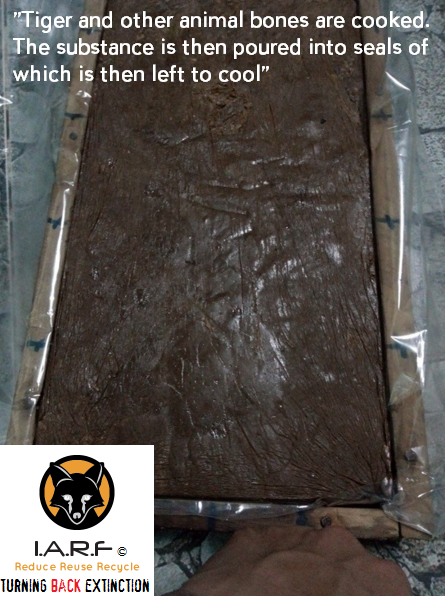
Image: Tiger bone glue, please click on the link in the image for information.
Tiger bone glue was said to be the most expensive wildlife product on the black market. Mixed with a wide number of synthetic drugs to cure so called illnesses and to act as a narcotic, environmentalists did state the glue is now mostly fake and hard to obtain due to the decreasing tiger numbers in the wild. Unfortunately with so many tigers still being bred in captivity within Asia - tiger bone glue is still available, priced higher than rhino horn and ivory.
The tiger trade is unique when compared to the illegal trade of other wildlife in Viet Nam, due to the relative rarity and high value of the commodity. This often results in traders taking extra measures to assure secrecy in their dealings (although that is something to be seen on Facebook). Viet Nam’s illicit tiger trade is carried out by elaborate criminal networks that avoid detection through the use of disposable cell phones, connections across international borders, and using friends in high places to facilitate a smooth and steady flow of their product to the consumer.
Most tigers confiscated in Viet Nam originate from foreign sources, smuggled into Viet Nam from Laos and Thailand where major farming operations exist that both produce and launder animals from the wild. A number of key figures behind the tiger trade in Viet Nam have been identified but manage to avoid prosecution by distancing themselves from criminal activities or operating under protection of local officials. Prosecutions tend to target low-level figures involved in transport or brokering sales. Only a minute few of these prosecutions result in prison time for anyone involved. (Source ENV Viet Nam).
While we would like to believe that most tigers are originating from over the borders there is also as explained zoos that are not being monitored, are breeding tigers, then selling them tigers onto traders. Finally we also have what we suspect is a number of African petting and breeding farmers involved in this trade that continues to flout legal loopholes in the law.
The wildlife trade on Facebook must come to an end. Please sign the petition hereto:
http://www.thepetitionsite.com/645/521/701/facebook-remove-illegal-pet-and-wildlife-traders-from-your-server/
Thank you for reading.
Dr Jose C. Depre
Chief Environmental Officer.
FACEBOOK: IVORY TRADE OFF THE SCALE | VIET NAM | PART I
FACEBOOK | IVORY TRADE IN VIET NAM
Written by Dr Jose C. Depre (Chief Environmental Officer).
By the time it takes me to finish this document an estimated 20-50 elephants will have been slaughtered. Once you turn your head and continue to do nothing, come tomorrow 100 elephants would have been killed for their ivory to supply the South East Asian black market. Back in January 2015 I launched yet another online and ground intelligence gathering operation relating to the illegal wildlife trade; We are focusing on China, Viet Nam, Laos, and Thailand of which the team, a twenty four strong experienced male and female unit originate from all backgrounds. Today I’m focusing more on the online trade which has now increased to worrying new levels.
Since January 2015 when [Operation Stop It] was launched Environmental Crimes Officers have found what we believe is a new trend of ivory trade in operation on the United States platform known as Facebook. External Affairs Officers became aware of the huge trade when investigating a Vietnamese national identified as Mr Trang from June 2015 to December 2015. Unfortunately since providing law enforcement agencies with masses of evidence just on this one trader; very little in the way of arrests and/or confiscations has been witnessed.
The ban on international trade in ivory was introduced in 1989 by CITES (Convention on International Trade in Endangered Species of Wild Fauna and Flora) after years of unprecedented poaching. In the 1980’s, an estimated 100,000 elephants were being killed per year and up to 80% of herds were lost in some regions. However despite the ivory trade ban in place, very little in the way of illegal trade reduction is being witnessed within Viet Nam, China, Laos, and Thailand.
Viet Nam is one country of interest that we’ve noted as hosting “unusually large amounts of (raw ivory tusks), most of which seem to be originating from impounded stocks, with other tusks clearly removed from ivory pyres”. While we are aware a large majority of ivory tusks are originating from Africa, there is also a significantly large amount also originating from Asia. Asian ivory tusks are more favored for carving over that of African elephant tusks.
Image: Two tusks located for sale on Facebook 16.05.16 from | impounded or stolen from pyres?
The two elephant ivory tusks (pictured above) were located on Facebook for sale yesterday which we suspect have originated from a recent or past ivory burn. Normally ivory tusks are white, or a dusty creamy color with some dark tinges to them; embers can clearly be seen on the left hand tusk with visible white dehydration and salt marks too.
Image: Ivory jewelry smuggled from Africa into South East Asia now on sale on Facebook.
While the online trade is no big secret, the fact is Facebook hosts no terms and conditions in place that bans such illegal trade; the Facebook platform has no systems in place to recognize such imagery (I.e raw tusks) using BOTS that can then report back to a third party Policing team. Finally IARFA Environmental Crimes Officers have found Facebook is being exploited by many South East Asian citizens primarily from Viet Nam, and Thailand peddling ivory from Asia and Africa.
Image: Ivory trader weighs up tusks he is trading online via pseudo Facebook account shops.
The image above clearly demonstrates just has serious the ivory trade has become online and on the Facebook social media platform. Traders will commonly show their products to prove their wealth (I.e as a status symbol), or to prove/demonstrate the legitimacy of their products compared to other traders, that may be selling counterfeit ivory. The trader who we can only be name as Mr Phong then demonstrates just how much he will be making come the end of the month. The total amount of ivory Mr Phong is selling on Facebook (pictured above and below) will fetch him around $15,000-$20,000USD depending on how the ivory is sold and/or manufactured.
Image: My Phong weighs up this illegal haul of ivory, fetching him some $15,000-$20,000USD
Despite international and domestic trade bans nothing is actually working, furthermore we do hold concerning evidence that shows without a doubt many tusks are being removed from compounds in Asia and Africa then sold onto the very people that police took the ivory from. Police have been witnessed trading confiscated ivory at high prices back into the hands of smugglers knowing too well they are going to make a good wage due to the high demand for ivory tusk products.
Back in 1992 Viet Nam officially outlawed the ivory trade, unfortunately since the ban was implemented any ivory that was purchased before “Viet Nam’s ivory ban” can still be sold legally so as long as the tusks host the correct certification; Fortunately CITES did rule that “re-worked ivory or any tusks/ivory products that were purchased before or after the 1992 Viet Nam ivory ban that are then re-worked, would then be classed as new ivory (non-exempt) thus making that product that was legal - now illegal.
Meanwhile back in 1975 international trade in “Asian elephant ivory” was also banned. There has been quite a few tusks examined by experts and third party experts located on the United States Facebook platform as originating from Asian elephants. Asian elephant tusks are much smaller than your average African bush elephant tusks. Come the 1980’s it was then stated no fewer than 50,000 Asian elephants existed which are now listed on CITES Appendix One and known to [endangered].
One out of every six Hanoi citizens are dealing ivory on the United States Facebook platform. Most of this ivory is as explained originating from Africa and Asia, with clear and obvious signs of trafficking, and thefts from impounded ivory and ivory pyres.
Image: One of many thousands of online ivory trading Facebook shops in Viet Nam.
The image above was picked up from one of many thousands of Viet Nam ivory traders. Traders establish a sophisticated network of “pseudo Facebook accounts”. These accounts are rarely in the real name of the trader. Traces of some accounts via the IARF Environmental Cyber Crimes Unit have shown ivory traders using Virtual Proxy Networks [VPNs] to conceal their Internet Protocol Address.
Furthermore when dealing over the phone traders normally use cheap (non-smart throw away phones) so that should enforcement agencies locate them, tracing the traders exact whereabouts, and who they are selling ivory onto is almost impossible. Its not uncommon to witness traders with a number of cell phones. One phone (the throw away one) will be used for trade and can easily be disposed of with all evidence destroyed containing names and numbers of ivory dealers and buyers. Meanwhile smugglers, traders and carvers also host a smart phone for normal everyday conversations and general surfing the web or interacting with friends and family on Facebook, Twitter or Weibo.
Back in March of 2016 International Animal Rescue Foundation’s- Environmental Crimes Officers located three Viet Nam ivory trading carving factories all advertised on the United States Facebook platform. Moreover it wasn’t just carvers and ivory advertised for sale; we also located evidence of ivory carving tools, measuring and weighing instruments and “DIY ivory carving instructions for beginners”. The carving instruments below were found in one Hanoi carving workshop (on the Facebook social media platform), meanwhile underneath the bottom image is proof of more raw ivory tusk carving.
Image: Ivory carving tools, Viet Nam, Hanoi used to intricately carve ivory.
Image: In the same carving room more raw ivory tusks were located readied for carving on Facebook.
Environmental Crime Officers have located a staggering 80,000 “ivory and wildlife trade shops” all in operation on the United States Facebook platform, yet little if anything is being done to stop this trade or even restrict traders activities. When submitting this evidence with films, images and Facebook accounts and the current laws on ivory trade to Facebook’s Security Head, Alex Stamos we we’re unfortunately ignored.
Yet Facebook’s moderation team are quite willing to remove accounts that have violated their “bullying, harassment or terrorism polices” (all of which are crimes), sadly the social media platform is unwilling to remove highly active wildlife traders breaking domestic and international wildlife laws that are making a ton daily.
On the 3rd March 2016 the BBC reported “Facebook wildlife trade prompts fears among environmentalists”. Traffic - an Environmental Crimes Investigation Organisation located hundreds of online profiles selling endangered and threatened animal species. Facebook stated “It will not hesitate in removing content that is promoting such trade”. Yet when we contacted Facebook submitting more than enough evidence relating to ivory, rhino horn, tiger and pangolin trade all accounts are still in operation.
Facebook did quote though “They are developing practical solutions to combat trade“, unfortunately these solution’s seem to aimed only at “animals rather than animal parts”. For the time being Facebook has no terms or polices in place that would remove illegal wildlife traders dabbling in rhino horn, tiger parts, pangolins, or [non-exempt] ivory. And with some 1.32+ billion Facebook users, Facebook will we believe now have a large job on their hands in combating such trade as from 2014 trade on the Facebook platform has exploded.
“Investigators are concerned that the use of social media and smartphones means that anyone interested in selling wildlife can rapidly access huge numbers of potential buyers”….
Image: More ivory Facebook shops churning out thousands of euro in ivory, all from raw re-worked tusks.
While Facebook has stated they are developing new measures and applications to combat trade, these new measures and whatever applications will be made to combat trade are all too late. Facebook is probably one of very few platforms where you can actually create “private groups”, where only those that are interested in such trade can enter and interact with other users.
Moreover Facebook provides you secrecy in relation to pages; I.e: Traders can censor which countries they don’t want to view their pages then continue trading whatever they like. In relation to pages there are ways and means around that censorship, which will not be published hereto.
One of the largest items we are seeing traded on Facebook is that of ivory bangles, ivory necklaces, ivory wrist bands, ivory chopsticks, ivory pens, ivory encrusted watches, ivory sex toys and ivory cigarette holders (in the thousands). Overseas tourists that visit Viet Nam are often caught or witnessed buying these small cheap products, and the longer they (the tourist) purchase from ivory carvers and traders, the longer demand will continue to increase and fan out. That is one area of the trade we need all be focusing on (demand) to nip in the bud sooner rather than later.
Ground Sales Survey of Ivory:
Back in 2014, a total of 1614 ground outlets were surveyed in 21 localities throughout Viet Nam. Eighty-five of these outlets (5%) were found to have a total of 2300 ivory items for sale. Buon Me Thuat city was found to have the highest percentage of shops (50%) offering ivory. However since CITES has placed more pressure onto Viet Nam to clamp down on ivory and other wildlife trade, these shops are slowly reducing trade, although we do highly suspect traders are now operating more freely on line from which policing this area of the trade is more difficult.
While it was stated that many shops on the ground had increased somewhat, law enforcement in Viet Nam has allegedly made it more difficult for traders to openly trade ivory that has no exemption. Its is for this reason we now believe Facebook is being used more and more to trade ivory products, and as one can see in the images above - we are talking massive amounts of ivory pieces and products, 90% of which hosts no certification, furthermore the vast majority of traders we’ve located are carving products from “smuggled ivory”.
It is presumed that the currency in which the price is listed or quoted in many ivory surveys may indicate the nationality of the most common buyers in that area. Both observations and questions to particular sellers substantiate the fact that ivory is sold to both “foreign tourists and Vietnamese nationals”. For example in HCMC, the majority of the ivory buyers in the two markets are assumed to be tourists from China as prices were quoted in Chinese Yuan.
Video: Bryan Christy examines the illicit ivory trade. Interesting we have also have located a number of “counterfeit tusks that are being traded online and on the ground”. Please stay tuned for article two that will delve a little deeper into both the counterfeit rhino horn, ivory and tiger part trade.
The HCMC silver and gold shops that also offered ivory (particularly the smaller, religious pendants and figurines) appear to be targeting Vietnamese buyers with prices advertised in VND. In Dak Lak and Ha Tien, the majority of the ivory buyers are assumed to be Vietnamese tourists as prices there were quoted in VND. In Ha Noi, prices were mostly given in USD when enquiries were made, which may indicate that the buyers of ivory pieces are likely to be international tourists.
While the majority of ivory is presumed to be aimed at mostly Asian tourists - there is no real hard hitting evidence that this is in deed true. For example if you was British you’re hardly going to purchase an ivory bangle in GBP, so exchanging that currency into Vietnamese dollars then places that ivory for sale (at just about everyone and anyone) with the correct currency.
It may be somewhat of a shock but the UK is the third biggest source of intercepted illegal ivory entering the United States of America (US), which has been singled out by CITES (the Convention on International Trade in Endangered Species of Wild Fauna and Flora) as a ‘problem country’ with a large domestic ivory trade likely to provoke illegal elephant poaching if not regulated and brought under control. London’s Portobello Road – the biggest antiques market in the world – has been identified as the single major source of this illegal ivory.
Furthermore while antique ivory trade is “problematic” so too is non-antique and the longer these trades persist, more and more elephants will be slaughtered for their tusks. We are growing very concerned now at the large number of ivory dealers operating on Facebook. There is clear evidence that much of this ivory is originating from both Africa and Asia, furthermore as explained - the large number of “raw tusks we are locating clearly shows that security is indeed more than questionable at ports, and pounds that hold confiscated ivory.
Image: Raw African ivory tusks, cut and sold onto Viet Nam carvers, on sale on Facebook.
Back in 2015 (just before Christmas) External Affairs Environmental Crimes Officers located an “unusual amount of raw tusks from Africa” that we suspect had made their way into Viet Nam from China. IARFEIA Officers located on the Facebook platform some 21 whole raw and non-certified elephant tusks, some of them even had blood around the bases indicating these were freshly poached ivory tusks; all of which is in violation of both domestic and international ivory trade laws.
Image: Vietnamese ivory carver aged 19 from Hanoi, Viet Nam.
The image above doesn’t really show much does it? although the other images below shows exactly what this talented young man has been creating from raw African and Asian elephant tusks (and is still creating today with his freinds - all college students). Ivory traders and dealers make no attempt at concealing their identity anymore neither. However there still remains a hardcore number of dealers that will continue to conceal their faces, names, and never post images onto Facebook that depicts them holding raw non-exempt ivory. This belief that ivory traders, peddlers, and smugglers were all but old, is now a myth. Today we’re witnessing traders and carvers as young as 16 years old, taking over from their parents thus fueling the ivory trade evermore on Facebook.
Image: Young trader named as Mr Manh exhibits his newly carved ivory pieces on Facebook.
Image:Mr Manh proudly shows one of many hundreds of ivory pens that are in great demand.
Image: Ivory pen with top off, Viet Nam, Hanoi.
Image: Ivory trader identified as Mr Trang proudly displays carved ivory on Facebook for sale.
Image: More freshly carved ivory cartridge pens on sale in Hanoi, via Facebook.
From 2015 (to date) IARFA Environmental Cyber Crimes Officers and the ground team External Affairs Environmental Crimes Officers have found that Viet Nam is “suspected” of peddling more ivory than China and Thailand. Cyber Crimes Officers are now locating every week on average of 2-3 “raw tusk dealers” operating on Facebook. Meanwhile the database of 80,000 ivory and wildlife trade dealers all operating on Facebook continues to increase by the week.
The whole purpose of this article is to wake people up, and open their eyes. We have a major problem on Facebook, and Alex Stamos Facebook Head Security Officer doesn’t seem to be taking much notice of this ongoing and rather concerning problem relating to just the ivory trade alone. We’ve not got much time left, there is an estimated 50,000 Asian elephants in Asia, and “known - some 600,000 African elephants remaining on the continent of Africa with a probable 1.2 million known but (uncounted).
Facebook has become a hotbed for the lucrative and illicit most illegal wildlife trade. And for the time being not a single thing is being done to control this trade. Please sign the petition hereto: http://www.thepetitionsite.com/645/521/701/facebook-remove-illegal-pet-and-wildlife-traders-from-your-server/
“The Extinction Clock is Ticking”
Thank you for reading.
Chief Environmental Officer, Dr Jose C. Depre.
Environmental Crimes Department.

